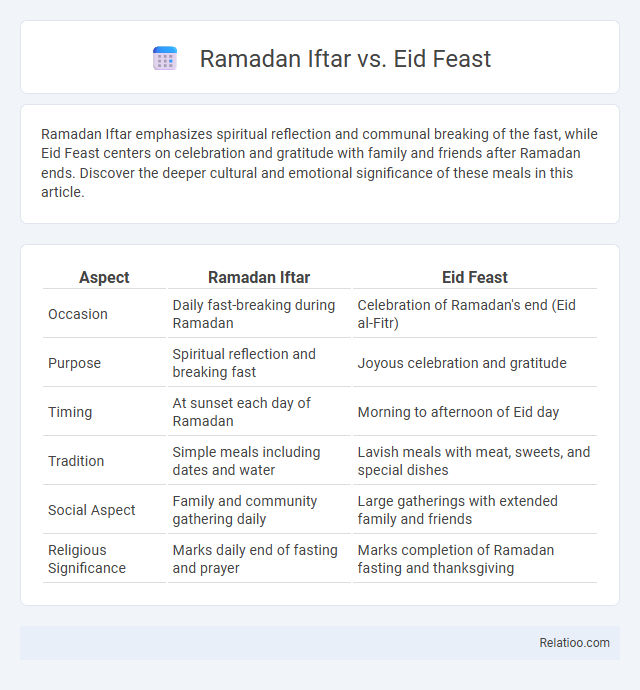Ramadan Iftar emphasizes spiritual reflection and communal breaking of the fast, while Eid Feast centers on celebration and gratitude with family and friends after Ramadan ends. Discover the deeper cultural and emotional significance of these meals in this article.
Table of Comparison
| Aspect | Ramadan Iftar | Eid Feast |
|---|---|---|
| Occasion | Daily fast-breaking during Ramadan | Celebration of Ramadan's end (Eid al-Fitr) |
| Purpose | Spiritual reflection and breaking fast | Joyous celebration and gratitude |
| Timing | At sunset each day of Ramadan | Morning to afternoon of Eid day |
| Tradition | Simple meals including dates and water | Lavish meals with meat, sweets, and special dishes |
| Social Aspect | Family and community gathering daily | Large gatherings with extended family and friends |
| Religious Significance | Marks daily end of fasting and prayer | Marks completion of Ramadan fasting and thanksgiving |
Introduction to Ramadan Iftar and Eid Feast
Ramadan Iftar marks the daily fast-breaking meal during the holy month of Ramadan, emphasizing modest, nutritious dishes like dates, soups, and light appetizers to replenish energy after fasting. In contrast, the Eid Feast celebrates the end of Ramadan with lavish, diverse meals featuring main courses such as lamb, rice, and rich desserts, symbolizing festivity and gratitude. Both occasions showcase distinct culinary traditions that foster community bonding and spiritual reflection in Muslim cultures worldwide.
Spiritual Significance of Iftar and Eid Celebrations
Iftar holds profound spiritual significance as the daily ritual of breaking fast during Ramadan, symbolizing self-discipline, gratitude, and communal harmony. Eid feasts mark the culmination of Ramadan, celebrating spiritual renewal, unity, and divine blessings with family and friends. Your participation in these traditions enhances spiritual growth and fosters a deep connection to faith and community.
Timing and Rituals: Iftar vs Eid Feast
Iftar, the daily sunset meal during Ramadan, marks the swift transition from fasting to nourishment, typically beginning with dates and water followed by a modest but wholesome spread. In contrast, the Eid Feast takes place once a year at the end of Ramadan, symbolizing celebration and gratitude, featuring elaborate dishes that vary by culture but often include meat, sweets, and special desserts. While Iftar emphasizes the ritual of daily fasting completion and spiritual reflection, the Eid Feast is a festive communal event highlighting abundance and joy after a month of discipline.
Traditional Foods Served at Iftar
Traditional foods served at Iftar during Ramadan include dates, lentil soup, samosas, and various types of kebabs, reflecting rich cultural heritage and regional diversity. These dishes provide a nutritious break to fasting, replenishing energy with a balance of proteins, carbohydrates, and essential nutrients. Your Iftar experience often emphasizes communal sharing and spiritual reflection, distinct from the celebratory and elaborate nature of the Eid feast that follows Ramadan's end.
Signature Dishes of Eid Feast
Eid Feast showcases signature dishes like biryani, kebabs, and sheer khurma, marking the culmination of Ramadan fasting with rich, celebratory flavors. These dishes contrast with Ramadan Iftar meals, which often feature lighter, quick energy foods like dates, samosas, and fruit juices to break the fast. Cooking for Eid Feast involves intricate preparation and a blend of aromatic spices, reflecting cultural traditions and festive joy.
Social Gatherings: Family and Community Aspects
Ramadan Iftar brings families and communities together each evening to break their fast with shared meals, fostering unity and spiritual reflection. Eid Feasts mark the culmination of Ramadan with festive gatherings, abundant food, and joyful celebration, strengthening social bonds among relatives and neighbors. Cooking during these events plays a vital role in preserving cultural traditions and encouraging collaboration among family members to prepare diverse and meaningful dishes.
Differences in Preparation and Atmosphere
Ramadan Iftar involves a serene and reflective preparation centered on fasting break, featuring dates, light soups, and communal prayers that create a spiritual atmosphere. Eid Feast preparation is more elaborate, incorporating rich, festive dishes like biryani and sweet desserts such as sheer khurma, emphasizing celebration and family gatherings. Your cooking approach adapts accordingly, from the simplicity of Iftar to the grandeur of Eid, reflecting the distinct moods and traditions of each occasion.
Cultural Variations in Iftar and Eid Feasts
Ramadan Iftar and Eid feast traditions showcase diverse cultural variations reflecting regional ingredients and cooking techniques. In Middle Eastern countries, Iftar often includes dates, lentil soups, and grilled meats, while South Asian cultures feature samosas, pakoras, and rich biryanis during both Iftar and Eid celebrations. Eid feasts frequently highlight elaborate cooking with sweets like baklava in the Levant and sheer khurma in the Indian subcontinent, emphasizing the distinct culinary heritage shaping festive meals worldwide.
Health Considerations During Both Occasions
Ramadan Iftar and Eid Feast often feature rich, calorie-dense foods that can challenge your digestive system and overall health if not managed carefully. Prioritizing balanced meals with nutrient-dense ingredients during both occasions helps maintain energy levels and prevents post-meal lethargy or discomfort. Incorporating hydration, portion control, and mindful cooking methods supports better health outcomes throughout Ramadan and Eid celebrations.
Conclusion: Celebrating Unity and Gratitude
Ramadan Iftar, the daily breaking of fast, emphasizes spiritual reflection and community bonding, while the Eid Feast marks the joyous culmination of Ramadan with abundant dishes symbolizing gratitude and celebration. Cooking during these events involves traditional recipes that bring families together, enhancing the sense of unity and cultural heritage. Your participation in these rituals fosters a profound connection to faith and shared values, reinforcing the importance of unity and gratitude in the Muslim community.

Infographic: Ramadan Iftar vs Eid Feast
 relatioo.com
relatioo.com